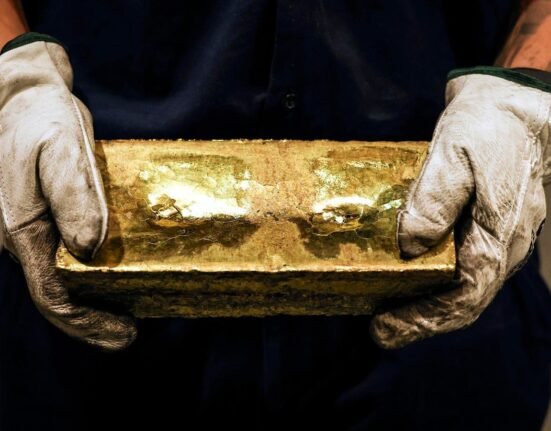If you’ve been watching the gold space in recent years, you may know that the precious metal has appreciated in value by over 750 percent since 2000, when it was under US$300 per ounce.
Even when adjusting for inflation, the value of gold is still up a significant 350 percent over that period.
Given that fact, investors may want to turn their attention to investing in gold as a retirement plan. While there are pros and cons to using gold for retirement savings, many successful investors consider the metal a safe-haven investment.
This is due to gold’s reputation for performing well during economic and political volatility. Additionally, gold tends to perform counter to the US dollar, meaning that when the dollar is weak, gold is often strong, and vice versa.
This means dedicating a portion of your retirement portfolio to precious metals could help hedge against inflation and dollar weakness. A 5 to 10 percent allocation is often recommended as a strong base.
But which options are right for you and your needs? Read on to find out about four ways you can invest in gold for retirement. From physical gold to gold exchange-traded funds and stocks to gold-backed assets, there are diverse options for those who choose to prepare for retirement with gold.
1. Buying physical gold for retirement
One of the first and perhaps most obvious gold investment options for your retirement portfolio is physical gold, typically purchased in the form of bullion coins or gold bars through a dealer. While that might sound simple, as with any investment, it’s important to do your research and make sure you’re using a reputable dealer.
Physical gold carries many benefits; it is a tangible, intrinsically valuable asset that can be sold when needed or when prices are high. However, as it doesn’t provide a return, gold must be sold to make a profit.
If you choose to buy physical gold, you’ll also have to consider where you’re going to keep your gold bars, coins or bullion. You could keep it in your home, but most advisors would sway you away from that method because you’ll need space and a secure place to put it, such as a safe. These are potential issues for those looking to downsize for retirement.
Many investors opt instead for the security and ease of keeping their gold at a bank depository. This does add extra costs to your investment due to storage fees and means you do not have immediate access to your gold.
You can find information on investing in physical gold for your IRA, which comes with stricter regulations, below. To get more information about physical gold as an investment, check out our guide here.
2. Investing in gold ETFs for retirement
For investors who want exposure to gold’s price without owning physical gold, gold-backed exchange-traded funds (ETFs) are an option to consider. Gold-backed ETFs are more accessible than physical gold as they are traded on stock exchanges and have a cheaper price per unit than an ounce of gold.
For North American and Australian investors, some options to consider are the SPDR Gold Trust ETF (ARCA:GLD), the iShares Gold Trust ETF (ARCA:IAU) and the BetaShares Gold Bullion ETF (ASX:QAU).
Investors with more risk appetite can look at ETFs that focus on major gold-mining companies, such as the VanEck Gold Miners ETF (ARCA:GDX), the VanEck Gold Miners AUD ETF (ASX:GDX) and the iShares MSCI Global Gold Miners ETF (NASDAQ:RING). These ETFs provide exposure to a basket of large gold stocks.
3. Investing in gold stocks for retirement
Individual gold stocks can also be an option when building a gold retirement portfolio, but they carry a higher level of risk compared to physical gold, as well as gold-focused ETFs.
Investors should consider focusing on dividend-paying, large-cap gold miners such as Newmont (TSX:NGT,NYSE:NEM), Agnico Eagle Mines (TSX:AEM,NYSE:AEM) and Barrick Gold (TSX:ABX,NYSE:GOLD).
Another option is large precious metals royalty and streaming companies, such as Wheaton Precious Metals (TSX:WPM,NYSE:WPM) and Franco-Nevada (TSX:FNV,NYSE:FNV); they also offer dividends.
Gold stocks can benefit investors who take the time to perform due diligence and sit down on a regular basis to determine whether their holdings continue to align with their wealth and savings strategy. For more on how to invest in gold stocks, check out these tips on resource investing from experts like Rick Rule, EB Tucker and Frank Holmes.
4. Investing in gold through an IRA, RRSP or SMSF
Finally, if you want to invest in gold for your retirement savings, you may want to consider investing in a gold-backed retirement fund. Options for American, Canadian and Australian investors are detailed below.
US investors can’t invest in physical gold via 401(k)s or regular individual retirement accounts (IRAs); it is only an option through a self-directed IRA, which can contain non-traditional investments such as real estate and precious metals.
There are other details to be aware of as well. For instance, the Internal Revenue Service (IRS) only allows at least 99.5 percent purity gold bullion bars and coins to be included in gold-backed IRAs, with the exception of American Eagle coins, which are 91.67 percent pure. Furthermore, gold used in gold-backed IRAs must be administered by an IRA custodian and stored at a location approved by the IRS — in other words, investors are not allowed to store this gold at their home.
For Canadians, tax-free savings accounts (TFSAs) and registered retirement savings plans (RRSPs) offer the ability to hold gold and silver, although they have similar purity and storage stipulations. Canadian investors have the option to choose between allocated and unallocated storage, meaning the precious metals they purchase can be kept separate or stored alongside other investors’ gold and silver. The latter option can help save on storage and insurance costs.
Similar to the US system, Australian investors are not able to invest in physical gold through regular superannuation funds, but they can do so through a self-managed superannuation fund, or SMSF. One point to note is that gold and silver coins are classified as collectibles, a category with very strict regulations. However, SMSFs do not classify bullion as a collectible, and it can be stored in your home, making it much more flexible.
Investor takeaway
All in all, it seems that investing in gold for retirement is much the same as investing in gold in everyday life: diversification is key. While gold can be a part of your retirement portfolio, you should make sure to have balance and choose the options that are right for you. Allocating 5 to 10 percent of your portfolio to gold through a mix of the options above could help support your investments during difficult times and provide strong value in the long run.
For further help deciding the best approach for your individual needs, consult a financial advisor who can help guide your investments to make sure you are on the right road to retirement.
This is an updated version of an article first published by the Investing News Network in 2016.
Don’t forget to follow us @INN_Resource for real-time news updates!
Securities Disclosure: I, Lauren Kelly, hold no direct investment interest in any company mentioned in this article.
From Your Site Articles
Related Articles Around the Web







